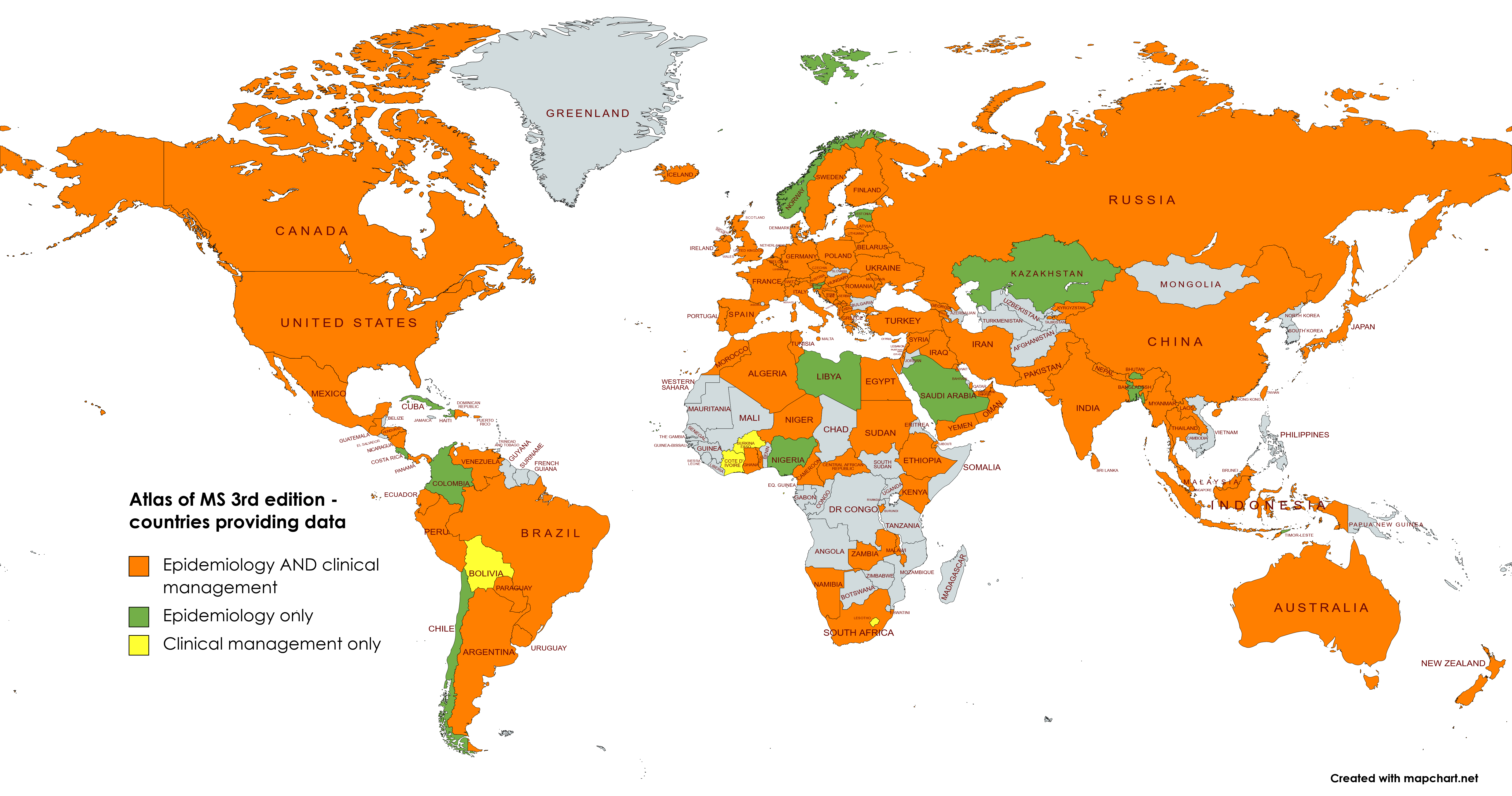What is the Atlas of MS?
The Atlas of MS is the most extensive worldwide study of the epidemiology of MS and the global availability and accessibility of resources for people with MS.
A unique, worldwide tool
The Atlas of MS is unique in that it is not a standard review of the published literature, but instead seeks to reach out to every country in the world asking them to provide the most up-to-date information on MS.


The Atlas of MS aims to bring together…
The Atlas of MS aims to bring together all available information on MS epidemiology and healthcare accessibility in an open-source data set. This gives us a more complete understanding of the burden of the disease and provides useful insights on how it varies across the world.
The first Atlas of MS – published in 2008 as a joint project by MSIF and the World Health Organization – was one of the most globally cited resources on MS.
The 2013 edition aimed to update the data and has been used to inform research initiatives as well as for campaigning and advocacy. This 3rd edition is in two parts:
Part 1: Epidemiology
Focused on the number of people with MS, how this varies across the globe, as well as demographic data such as age and gender.
Part 2: Clinical management of MS
Looks at the clinical management of MS and places particular emphasis on the barriers to accessing healthcare and disease modifying treatments.
Methodology
The data for the Atlas has been collated via a large international study with the data collection for epidemiology taking place between September 2019 and April 2020. 3 new countries were added December 2021 and data updated for 2 others. In 2022, we reached out to countries again, asking them to update core epidemiology data, as well as provide answers to a topical survey on Disease Modifying Therapies (DMTs) and Expanded Disability Status Score (EDSS).
What the questionnaire covered
The questionnaires were available in English, French and Spanish.
- The 2020 epidemiology survey covered the number of people with MS (prevalence), the number newly diagnosed with MS each year (incidence), average age of diagnosis, type of MS at initial diagnosis and national patient registries. The 2022 core data update focused on prevalence and incidence.
- The clinical management survey focused on the the following topics: diagnostic criteria used, barriers to diagnosis, types of disease modifying therapies used and barriers to accessing them, symptomatic therapies and rehabilitation, numbers of health care professionals, national guidelines and standards for MS diagnosis and treatment.
- The 2022 Topical survey, asked questions about the types of DMT used for MS (as many more DMTs had become available since our clinical management survey), the proportion of people treated with each DMT, affordability of DMTs amongst people with MS and proportion of people allocated to Expanded Disability Status Scale (EDSS).
Identifying expert country coordinators
Country coordinators were identified in 138 countries to be the focal point for gathering the relevant information in each country, making use of all possible sources of information and collaborating with other experts where possible/necessary. Typically, they were representatives from patient organisations, neurologists, epidemiologists or researchers.
Countries that didn’t take part
The remaining nations of the world (80) did not have an identified coordinator or did not agree to participate – these tended to be countries without patient organisations or where neurologists could not be identified or those with small populations.

Experts in 118 countries responded to the epidemiology module representing 87% of the world population. Response was slightly lower for the clinical management survey, with experts in 107 countries responding, representing 82% of the world population.
Participating countries are highlighted in the map below

Limitations
The Atlas of MS is one of the most comprehensive global data sources on the epidemiology and clinical management of MS, but it still has some limitations.
• Direct comparisons with previous data are difficult: Our global prevalence calculation methods have varied across editions as we strive to improve the accuracy. The number of countries participating varies, as does the proportion of the population covered in each region/income band. Additionally the treatment landscape has changed dramatically since the previous updates.
• Availability and quality of epidemiological data can vary considerably across countries. In addition few peer-reviewed publications exist on the availability of and access to MS diagnosis and treatment. To build a comprehensive picture of healthcare in different countries, we therefore relied on the expert opinion of clinicians or specialists with knowledge of that country. To improve confidence in the data collected, we asked country coordinators to collaborate with other experts when submitting answers to the survey and to report data sources if available.
• Although there are improvements in the number of countries providing data, there are still significant gaps in our knowledge (particularly from low income and African countries). We hope that the Atlas of MS will stimulate new and rigorous surveillance within countries and across the globe.
• It is challenging to separate ‘availability’ from ‘access’ – although the data indicates if diagnosis, healthcare professionals and therapies are available within a country, this doesn’t mean that these can be accessed by every person living with MS. Availability can vary considerably within a country and access is affected by other factors.
• Furthermore, the vast majority of our data collection took part prior to the start of the COVID-19 pandemic and therefore the access barriers we have highlighted are likely to have been exacerbated by the current situation.

For more information
Please download our full reports, our open-access epidemiology paper published in the Multiple Sclerosis Journal, the full data sets, other documents and tools or review our Atlas question and answer pages.